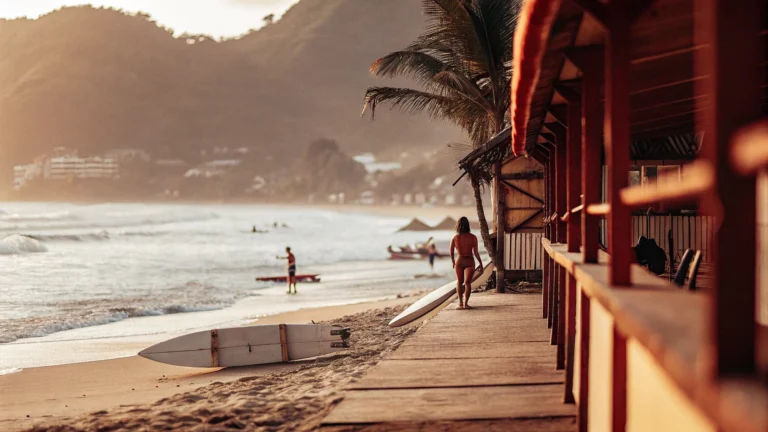What to Bring to the Beach 5 Clever Things You’ll Love
I still cringe thinking about Memorial Day weekend 2022. Picture this: I’m at Myrtle Beach with my family, feeling pretty smug about my beach prep skills. Had my checklist, packed everything the night before, even remembered the ice packs.
Then reality smacked me in the face. Hard.
My brother’s phone died just as we were trying to coordinate lunch plans with my parents who’d wandered off somewhere. Our cheap Target umbrella literally cartwheeled down the beach during a random gust of wind – I’m talking full gymnastic routine here. And don’t even get me started on the lukewarm sodas by noon or the fact that we sat there staring at each other for three hours because nobody thought to bring anything fun to do.
That day taught me something important: there’s a huge difference between packing for the beach and packing smart for the beach.
Since then, I’ve become that person who other families ask for advice. You know, the one with the setup that makes everyone else go “Where did you get that?” I’ve spent weekends talking to lifeguards, beach rental folks, and seasoned beach bums who’ve figured out what actually works.
Here’s what I wish I’d known back then – five things that’ll completely change how you experience beach days.
Why Most Beach Trips Fall Short (And How to Fix Yours)
Let’s be honest – most of us pack for the beach like we’re going to our backyard. Towel, sunscreen, maybe a cooler if we’re feeling fancy. But the beach throws curveballs your backyard never will.
Heat kills phone batteries faster than you’d believe. Wind turns flimsy umbrellas into projectiles. Ice melts stupid quick in direct sunlight. And after two hours of just lying there, even paradise gets boring.
Smart beach packing isn’t about bringing more stuff. It’s about bringing stuff that actually handles beach conditions.
Here’s how I think about it now:
ProblemTypical SolutionWhat Actually WorksDead phonePray it lastsSolar power bankFlying shadeChase it down beachProper anchored shelterWarm drinksBuy more iceReal insulated coolerBoredomScroll dead phoneWaterproof activitiesLost valuablesLeave in carHidden storage
The difference? Items that work when you actually need them, not just in perfect conditions.
Must-Have #1: Solar Power Bank (Your Sanity Saver)
This changed my entire beach experience. Seriously.
Your phone isn’t just a phone anymore – it’s your camera, music player, weather radar, and emergency contact device all rolled into one. But beach heat murders batteries. I’ve watched phones go from 80% to dead in under two hours.
Solar power banks solve this problem completely. They charge while you’re having fun, work anywhere with sun, and most can juice up multiple devices at once.
Real talk about solar chargers:
- They actually work (I was skeptical too)
- No more cutting beach days short for charging runs
- Great for helping other people (instant beach hero status)
- Many have built-in flashlights for evening walks
- Much more environmentally friendly than single-use battery packs
Last summer at Outer Banks, a family’s van wouldn’t start because they’d drained the battery charging phones all day. Guess who became their favorite person? The guy with the solar power bank who helped them call roadside assistance.
What to look for:
- 25,000+ mAh capacity (that’s roughly 6-7 phone charges)
- Multiple USB ports (2 minimum, 3 is better)
- Actual waterproof rating – IPX7 or higher
- Foldable solar panels for faster charging
- Sturdy build that won’t break in your beach bag
I spent $55 on mine eighteen months ago. Best beach investment I’ve made, hands down. No more anxiety about dead phones or missing important calls.
Must-Have #2: Shelter That Actually Stays Put
Remember my flying umbrella story? That $15 piece of junk taught me an expensive lesson about beach physics.
Sand shifts. Wind changes direction without warning. Those little spiral tips on cheap umbrellas? Basically useless once the sand gets soft from foot traffic.
After talking to a longtime Ocean City lifeguard, I learned what actually works: shelters designed for beach conditions with proper anchoring systems.
Types that won’t embarrass you:
Pop-up canopies with weight bags – My current go-to. Sets up in under five minutes, handles wind from any direction, provides way more shade than umbrellas.
Beach cabanas with sand anchors – Heavier to carry but incredibly stable. Great for all-day setups.
Hybrid tent-shelters – Best of both worlds. Quick setup, excellent stability, works for overnight camping too.
Shelter StyleSetup TimeWind HandlingShade CoverageMy RatingCheap umbrella1 minuteTerribleSmall circle1/5 (never again)Pop-up canopy4 minutesExcellentLarge square5/5 (current favorite)Beach cabana8 minutesOutstandingMedium rectangle4/5 (great but heavy)Hybrid shelter6 minutesExcellentAdjustable4/5 (versatile option)
The canopy I use now has survived 25+ mph winds without budging. It’s got sandbag anchors that actually grip, and the shade coverage is huge compared to umbrellas. Setup takes maybe four minutes once you get the hang of it.
Cost me about $85 two years ago, and it’s still going strong.
Must-Have #3: Cooler with Secret Compartments
This one’s about more than keeping drinks cold – though that’s important too.
Standard coolers fail at the beach because they’re designed for backyard parties, not eight hours in direct sunlight. Plus, where do you put valuables while swimming? Leave them on your towel and hope for the best?
Smart coolers solve both problems. They keep ice frozen for days, not hours. And the hidden compartment feature is brilliant – nobody’s digging through ice water looking for your wallet.
What makes a cooler beach-worthy:
- Rotomolded construction (way tougher than cheap plastic)
- 2-3 day ice retention in hot weather
- Hidden/lockable compartments for valuables
- Built-in extras like bottle openers or cutting boards
- Drainage that actually works (no tipping required)
- Wheels that roll in sand
The hidden storage thing is genius. Car keys, wallet, jewelry – all safe in the cooler where thieves won’t look. I can actually relax in the water instead of constantly checking my stuff.
My cooler shopping lessons:
- Ice retention claims are usually optimistic – cut them in half for beach reality
- Wheels make a huge difference when loaded with ice and drinks
- Look for lifetime warranties (good brands offer them)
- Size vs. weight when full matters more than you think
- Read reviews specifically about sand performance
Mine cost $135 three summers ago. Sounds like a lot until you factor in ice savings, security peace of mind, and not replacing cheap coolers every season. It’s actually saved money long-term.
Must-Have #4: Waterproof Speaker That Handles Sand
Music transforms beach experiences. But regular Bluetooth speakers die quick deaths at the beach.
Sand is evil to electronics. Gets in charging ports, speaker grilles, button gaps. Salt air corrodes metal parts over time. You need something built specifically for this environment.
Features that actually matter:
- True waterproofing (IPX8 minimum – should handle full submersion)
- Sand-resistant design with sealed ports
- 360-degree sound projection
- Float capability (trust me on this)
- 12+ hour battery life
- Decent bass that carries over wave noise
How I actually use mine:
- Background tunes during setup and breakdown
- Podcasts during solo relaxation time
- Sound effects for group games
- Weather alerts (saved me from a sudden storm last year)
- Hands-free phone calls
- White noise for beach naps
The weather alert thing is clutch. My weather app pushed a severe thunderstorm warning through the speaker last August. I was so zoned out I hadn’t noticed the dark clouds building. Got packed up and to the car just as the rain hit.
Current speaker cost around $75, floats like a cork, and has survived two full beach seasons of abuse. Sound quality surprised me – much better than expected for something so rugged.
Must-Have #5: Activity Kit for When Lounging Gets Old
Here’s what nobody warns you about – beaches can get boring. Especially during long days or family trips with kids who’ve already built every possible sandcastle.
Having activities ready prevents the dreaded “Now what?” moments. However, you can’t just throw games at random. Beach activities need to work in wind, sand, and changing conditions.
Active stuff that works:
- Portable volleyball/badminton net (adjustable height is key)
- Soft frisbees and flying discs (safer in crowds)
- Beach bocce ball or bowling sets
- Spikeball (incredibly fun once you learn)
- Cornhole boards that fold flat
Chill activities:
- Waterproof playing cards in sealed container
- Travel board games with magnetic pieces
- Waterproof notebooks and pens
- Brain teaser books
- Adult coloring books (don’t judge – they’re relaxing)
Water fun:
- Basic snorkel gear (mask and snorkel minimum)
- Floating pool games that work in waves
- Waterproof dice for ocean games
- Water balloons for hot days
Activity TypeBest WeatherEnergy LevelSetup TimeStorage SpaceCard gamesAnyLow30 secondsTinyNet sportsNot too windyHigh5 minutesMediumWater activitiesHot and calmMedium2 minutesSmallCreative stuffCloudy/coolLow1 minuteSmall
Key is having options. Some days you want action, others you want chill. Weather changes plans. Kids get restless. Adults need mental breaks. Having variety means you’re ready for whatever happens.
Packing Strategy That Won’t Break Your Back
I know, I know – this sounds like a lot to haul. But here’s my system that makes it totally manageable.
Weight distribution is everything:
- Heavy items (cooler, shelter) get wheels or go in a wagon
- Daily-use stuff (phone charger, speaker) stays easily accessible
- Everything has a designated spot and backup protection
- Most-used items get unpacked first, packed last
My actual packing routine: □ Solar charger in waterproof case (top of beach bag) □ Shelter and ALL anchor pieces (separate bag – don’t forget stakes!) □ Cooler pre-loaded and wheels tested before leaving □ Speaker fully charged and tested (learned this the hard way) □ Activity kit sorted by type (active/water/chill) □ Extra waterproof bags for sandy/wet items
Everything fits in my SUV with room for passengers. Beach setup takes about 12 minutes total once you get the rhythm down.
Pro packing tips:
- Pack a “quick access” bag with essentials for fast bathroom runs
- Bring one backup of everything electronic
- Use mesh bags for sandy toys – they drain and dry fast
- Keep a dedicated beach towel for equipment drying
Smart Shopping: How to Build This Kit Without Going Broke
Look, this stuff adds up fast. You don’t need everything at once. Here’s how I’d prioritize on a budget:
Buy first (biggest impact):
- The most prevalent issue is resolved with a solar power bank ($40–60).
- Proper shelter ($70-120) – makes everything else possible
Add next (major comfort upgrades): 3. Quality cooler ($100-180) – pays for itself in ice savings 4. Waterproof speaker ($60-90) – completely changes the vibe
Build over time: 5. Activity collection ($50-100) – accumulate during sales and clearances
Money-saving strategies:
- Shop end-of-summer clearances (August-September)
- Check estate sales and Facebook Marketplace
- Split costs with beach buddies who’ll use stuff together
- Buy one quality item instead of three cheap ones
Actually found my cooler at a garage sale for $40. Original owner used it twice, decided RV life wasn’t for them. Sometimes patience pays off.
What to avoid:
- “As seen on TV” beach gadgets (usually junk)
- Anything without real user reviews
- Items that only work in perfect conditions
- Super cheap versions of important gear (false economy)
Seasonal Beach Strategies
Different times of year need different approaches. What works in July might flop in October.
Spring beaches (March-May):
- Weather’s unpredictable – bring layers
- Fewer crowds mean more space for activities
- Wind can be stronger – extra anchor gear
- Water’s cold – more land-based fun
Summer peak season (June-August):
- Maximum sun protection needed
- Crowds limit space for big activities
- Heat management becomes critical
- Early arrival essential for good spots
Fall beach trips (September-November):
- Perfect weather but cooler evenings
- Longer days possible with right gear
- Different activity focus (less swimming, more exploring)
- Photography opportunities are incredible
Fall beaches are actually my favorite. Fewer crowds, amazing light, comfortable temperatures. Just need to plan for temperature swings between day and evening.
Honest Mistakes I Made (So You Don’t Have To)
Three years of testing beach gear taught me some expensive lessons:
Dumb purchases I regret:
- $200 “premium” beach chair that was impossible to carry
- Fancy beach bag that looked great but held nothing practical
- A solar shower that was difficult to operate and took ages to heat up
- Bluetooth cooler with app connectivity (seriously unnecessary)
Cheap-out failures:
- $8 speaker that died after one beach trip
- Generic power bank that barely held a charge
- Flimsy activity net that lasted exactly one windy day
- Knockoff cooler that couldn’t keep ice overnight
Game-changing discoveries:
- Multi-use items beat single-purpose gadgets every time
- Redundancy matters – always have backup power cables
- Test everything at home first (learned this with a dead speaker)
- Sometimes the mid-range option is the sweet spot
Things that surprised me:
- How much difference good shade makes to everything else
- Solar charging actually works well (I was skeptical)
- Hidden cooler storage eliminated my biggest beach worry
- Having activities ready prevents family meltdowns
Biggest lesson? Invest in solving your actual problems, not imaginary ones. I spent way too much on gear that looked cool but didn’t address real beach day pain points.
Making Your Next Beach Day Actually Perfect
Your beach experience doesn’t have to include dead phones, flying umbrellas, or endless “what should we do now?” conversations.
These five items – solar power bank, proper shelter, smart cooler, waterproof speaker, and activity kit – solve the problems that ruin otherwise perfect beach days.
Start with whatever bugs you most. Maybe it’s always worrying about your phone dying. Or getting frustrated with shade that won’t stay put. Pick one problem, get the right solution, and watch how much better your next beach trip becomes.
The goal isn’t hauling tons of gear to the beach. It’s bringing the right gear that multiplies your fun and eliminates stress before it starts.
Once you experience a beach day where everything just works – where your devices stay powered, your shade stays put, your drinks stay cold, and you have genuinely fun things to do – you’ll wonder why you waited so long to upgrade your setup.
Your future self will thank you. And so will everyone you’re with.
Common Beach Questions (From Real Experience)
What to bring to the beach for an amazing day? Focus on solving real problems, not just bringing traditional stuff. A solar power bank keeps devices alive, proper shelter stays put in wind, a quality cooler keeps things cold AND protects valuables, waterproof speakers provide entertainment, and activity kits prevent boredom. These five things turn ordinary beach days into memorable ones.
What should I absolutely not forget when planning what to bring to the beach? Don’t forget backup power for your devices and shade that won’t blow away. I can’t stress this enough – dead phones and runaway umbrellas ruin more beach days than anything else. Also bring way more water than seems necessary. Dehydration sneaks up fast.
How can I decide what to bring to the beach without overspending? Start with multi-purpose items that fix your biggest problems. A solar charger with waterproof protection handles power AND phone safety. A cooler with hidden compartments manages food storage AND valuables security. Buy one quality item that lasts years instead of cheap stuff you’ll replace every season.
What to bring to the beach that nobody else thinks of? Most people forget about reliable power sources, proper anchoring systems, and backup entertainment. Solar chargers, sand-resistant speakers, and comprehensive activity kits separate experienced beachgoers from frustrated beginners. Hidden storage for valuables is also huge but rarely considered.
What’s the single most important factor when deciding what to bring to the beach? Think about preventing problems before they happen. Consider power needs, weather changes, food safety, entertainment gaps, and comfort basics. The best beach days happen when you’re prepared for different scenarios without turning into a pack mule. Focus on items that handle multiple jobs well.
What’s been your biggest beach day disaster? Tell me in the comments – I love hearing other people’s stories and helping figure out solutions!




